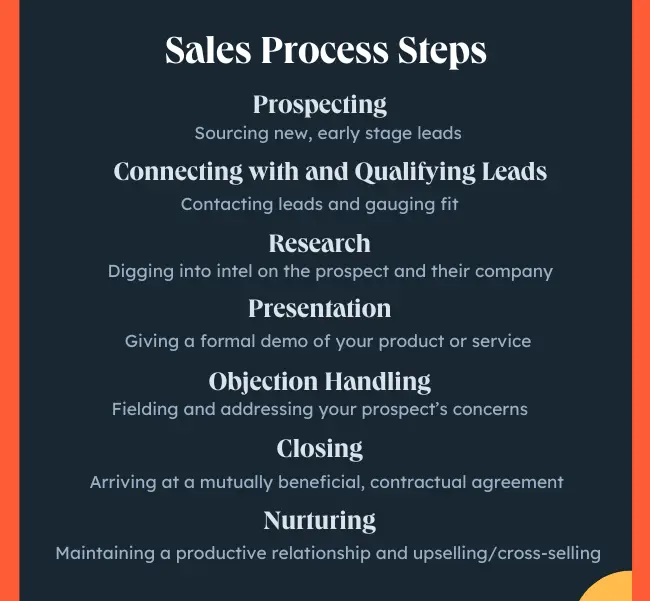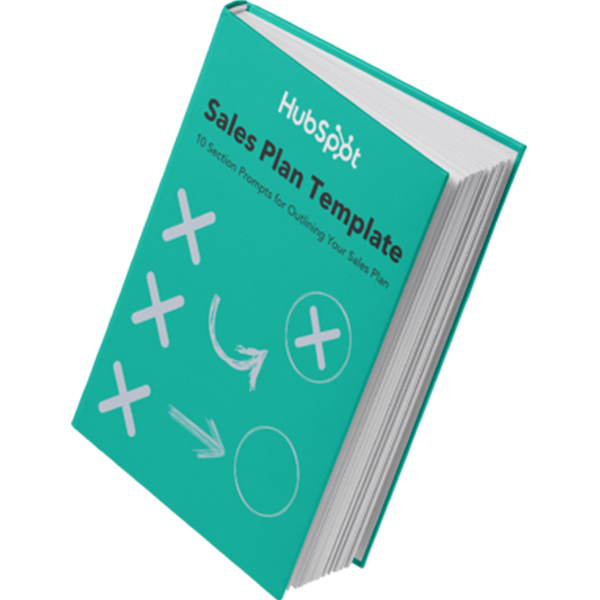A sound sales process is the backbone of any productive sales engagement. It gives you the structure, roadmap, and reference points necessary to sell with thoughtfulness and consistency. Even though a sale always requires some degree of improvisation, finesse, and creativity, you can't just wing every deal you work on and expect to see results.
That‘s why virtually every sales org has one of these processes in place — and a solid one can ensure you prospect, qualify, research prospects, pitch, handle objections, close, and nurture as effectively as possible. So by now, you’re probably thinking, “Holy heck! These sales processes sure do sound important! How on Earth do I put one together, and once it's in place, how can I ensure that my sales org and I abide by it?”
Well, hypothetical reader who asks all of the questions I want them to ask, you‘re in luck! Here, we’ll cover all of those bases — going over what a sales process is, the steps that generally comprise one, how to improve yours, and some handy examples you can reference. Let's dive in!
- What is a sales process?
- Sales Process Steps
- How to Improve Your Sales Process
- Sales Process Mapping
- How to Create a Sales Process
- Sales Process Flowchart
- Sales Process vs. Sales Methodology
- Sales Process Examples
- Common Sales Process Mistakes
What is a sales process?
A sales process refers to a series of repeatable steps a sales team takes to move a prospect from an early-stage lead to a closed customer. A strong sales process helps reps consistently close deals by giving them a framework to follow.
Why build a sales process?
As I said at the beginning of this post, I like to think of a sales process as both the backbone of and a roadmap for a successful sales engagement. It provides the structure and direction you need to capitalize on the leads your marketing generates — from prospecting to closing and beyond. Some other key benefits include:
- Facilitating smooth onboarding. A standardized sales process also helps less experienced reps get up to speed quickly — having that kind of framework in place ensures that you can train reps with some degree of consistency and give them a solid understanding of what they need to do at any given point in a sale.
- Making revenue generation more predictable. Forecasting is much more erratic without a solid sales process in place — establishing one of these frameworks allows you to keep tabs on the prospects in your pipeline more closely and, in turn, have a more accurate picture of how much revenue you'll ultimately generate.
- Allowing you to iterate and improve how your sales org sells. If you don‘t have a sales process in place, you won’t have a basis to improve upon when you‘re not hitting KPIs. In short, if you don’t have an established sales process, you're shooting in the dark.
Now that you know what a sales process is and why you should create one, let's consider the stages or steps that a typical sales process follows.

Sales Process Steps
- Prospect.
- Connect and qualify leads.
- Research the company.
- Give an effective pitch.
- Handle objections.
- Close the deal.
- Nurture and continue to sell.
1. Prospect.
Prospecting is the process of sourcing new, early-stage leads to begin working through the sales process. It's a vital part of the sales process — one that most reps generally fold into their daily or weekly workflow.
The term “prospecting” covers a broad range of strategies, activities, and methods — the combination of which can differ from sales org to sales org. Some prominent prospecting methods include:
- Cold calling
- Cold emailing
- In-person networking
- Leveraging social media sites like LinkedIn
That list isn't exhaustive, but hopefully, it gives you a sense of what this stage generally entails — contacting and connecting with ideally good-fit, potential prospects.
Prospecting might involve online research on sites like LinkedIn or Quora. It also might take place at conferences or industry events. Additionally, you can prospect by asking current clients or colleagues to refer individuals who might be interested in your product or service.
Hot Tip: Try to solicit referrals from your existing customers when prospecting. Word of mouth might be the most powerful resource sales orgs can tap into when connecting with potential customers. People trust the people they know more than an SDR on the other side of a cold call. Keep your customers happy, and try to have them put you in touch with their peers.
2. Connect and qualify leads.
The connect step of the sales process involves reps initiating more involved contact with those early-stage leads to gather information. From there, your team can start qualifying new leads — deciding whether or not they're a good-fit lead for your solution and, in turn, worth the time and effort that comes with a sales engagement.
Reps generally identify qualified leads over a “connect” or “discovery” call — a conversation where a sales professional asks questions tailored to tease out the kind of information that indicates whether a prospect's business has the need for and interest in an offering like yours.
You can generally get there by asking qualifying questions like:
- “What is your role within your company?”
- “What do you do day-to-day?”
- “What problem are you trying to solve?”
- “Why is this a priority for your business?”
- “What other solutions are you evaluating?”
Hot Tip: The BANT — budget, authority, need, timeline — framework provides one of the better-structured, more straightforward avenues for determining whether winning your contact‘s business is viable and if they’re the right person to be talking to.
3. Research the company.
Next comes the research step — which is exactly what it sounds like. It‘s the stage where reps take a more focused look at qualified leads to get a more fleshed-out sense of who they’re talking to.
In the context of a sales process, research generally entails scouring a prospect's business public-facing resources — including financials, company websites, profiles on company leadership, mission statements, and other elements that can provide context into why a company is considering your offering and how to best appeal to its decision-makers.
Sound, thorough research can help you put yourself in your prospect's shoes and allow you to frame a specific value proposition that accommodates their most pressing pain points.
The crucial part of this stage is understanding each prospect's challenges and needs and establishing your product or service as the solution.
While you might find that the companies in your vertical run into similar challenges, consistently raise similar objections, and have similar goals, no two businesses are exactly the same — so conducting the kind of research that reveals unique aspects of the business you're engaging with is invaluable when trying to speak to them on a more focused, specific level.
Hot Tip: Research shouldn‘t stop with you understanding a prospect’s broader business interests — you also want to identify a deal's most relevant stakeholders and determine an effective (but not overreaching) way to appeal to them personally. If you can, use this phase to determine whether your contact is the right person to be talking to. In some cases, you might be able to get that person to champion your solution, only to find out that they lack the authority to move a deal along.
4. Give an effective pitch.
Once you've established contact with a relevant stakeholder and made enough of an impression to pique their interest, you typically move onto the presentation stage — this step generally entails booking and conducting a formal product or service demonstration.
This step is time-consuming, so it typically comes later in the sales process and is reserved for more qualified prospects — making the connecting and qualifying step so critical. You don‘t want to waste the time and effort a demo takes on a prospect who’s not poised to or interested in actually buying.
Tailor each presentation to meet the specific prospect's unique use case and pain points. Additionally, a rep might bring an engineer or executive to the meeting with them to demonstrate the level of service the customer will receive when doing business with your company. This also allows them to answer more technical questions the rep might not be best suited to answer.
Hot Tip: I just touched on this, but I‘ll stress it again — personalization is key here. You want to make your demo as immediately relevant to your prospect’s pain points as possible. A vague, broad-stroke demo that walks through the nuts, bolts, and features of your product or service won't do too much for you.
You want to find a way to speak to the benefits and outcomes your prospect can expect to see as a result of leveraging your solution — both with respect to their business goals and personal day-to-day.
5. Handle objections.
Objection handling is a frustrating but virtually unavoidable fact of sales life — that's why it has a designated stage in pretty much every sales process. You and your team need to have the composure, product knowledge, and good sense to allay concerns as prospects raise them.
It‘s easier said than done, but you need to know your offering and prospect’s circumstances well enough to anticipate the issues they might raise. Leverage the insight you‘ve gathered in the previous stage — along with the perspective you have about your vertical that you’ve accrued throughout your career — and use it to prep thoroughly enough to preempt the objections that might come up.
And once you‘re actually in the meeting, be sure to meet objections with tact, empathy, and understanding. Don’t be rude, callous, or dismissive — even if you think your prospect's objections might warrant it.
Hear them out. Successfully handling a prospect's objections can go a long way when it comes to affirming your value proposition and framing yourself as a consultative, valuable resource as you approach closing.
It's not uncommon for prospects to have objections to your salesperson‘s presentation and proposal. In fact, it’s expected — which is why this is a specific step in the sales process. Your sales team should be prepared to handle any and all objections.
Listening to your prospect's objections and questions can help your reps better tailor your product to fit their needs. Through their research and presentation preparation, reps should identify and anticipate possible objections, whether about cost, onboarding, or other parts of the proposed contract.
Hot Tip: Some common objections prospects raise revolve around:
- Pricing
- Your company‘s reputation (especially if you’re getting off the ground)
- Whether a prospect actually needs a solution like yours
- Whether the need for your solution is a priority for them
No matter the objection, you always need to actively listen to your prospect‘s concerns, affirm that you understand the rationale behind their objection, ask thoughtful follow-up questions, and ideally point to any social proof you have that demonstrates your solution’s effectiveness.
In short, tell them you know where their objection is coming from, and present concrete evidence that you can address it.
6. Close the deal.
This step of the sales process refers to any late-stage activities that happen as a deal approaches closing. It varies widely from company to company and may include delivering a quote or proposal, negotiation, or achieving the buy-in of decision-makers.
Closing a sale is what every salesperson wants to achieve. It should result in a mutually beneficial, contractual agreement between the prospect and the seller. Once a deal closes, the salesperson receives a commission on the price they negotiated with the customer, and the account usually passes to an account manager or customer success representative.
Hot Tip: There is a wide range of closing strategies you have at your disposal. Not all of them will work with every prospect — but having some of these tactics in your repertoire to reference and build upon can be a big help.
7. Nurture and continue to sell.
Your sales process shouldn't end with closing. Taking the time to consistently and proactively nurture the relationships you establish will go a long way in minimizing churn and generating new business.
Happy customers are some of the most valuable resources your business can have. People talk, and potential customers generally trust word of mouth from their friends, colleagues, and peers more than any other potential outreach avenue you can leverage.
Always confirm that your customers receive what they've purchased — and play an active role in helping customers transition to whichever team is responsible for onboarding and customer success.
The final step of the sales process also involves continuing to communicate and reinforce value to customers. This can provide opportunities to upsell and cross-sell, as well as opportunities to get secure referrals from delighted customers.
Hot Tip: Early on in the sales process, mention the service and customer success reps who will be helping your client onboard after the deal closes. That way they're familiar, at least by name, with the team who will be taking over, and the transition will feel less abrupt.
Next, let's unpack how you can improve this process.
How to Improve Your Sales Process
- Analyze your current sales process.
- Outline the buyer’s journey for your target persona.
- Define the prospect action that moves them to the next stage.
- Define exit criteria for each step of the sales process.
- Measure your sales process results.
These best practices will help you improve the impact of your sales process across your team and customer base.
1. Analyze your current sales process.
This one might go without saying — but if you‘re going to iterate and improve upon your existing sales process, you need to know why you need to change it in the first place. Consider what is and isn’t working for your sales reps to tailor your new process to better fit their needs.
It's easier said than done, but you need to audit your existing process and identify as many gaps and inefficiencies as possible — that can start with you observing your reps as they work. Look back at the last five or ten deals you closed. What did these deals look like from beginning to end? What were the touchpoints with the customer?
Consider roughly how long the entire process took and how much time elapsed between each step. The more examples you have (and the more people on your team those examples come from), the better.
Once you've outlined that timeline, work backward to understand the timeframe for each deal. For example, if six of those ten deals closed in approximately six weeks, take a look at the average steps to get there during that period.
Hot Tip: Working backward might look something like this:
- One week of deliberation before a signed contract (during the “closing” step)
- Three to five follow-up emails and phone calls (during the “handling objections” step)
- One demo (during the “presenting” step)
- One phone call and two to three emails (during the “researching” step)
- One discovery call (during the “connecting” step)
- Two warm emails and three phone calls to prospect (during the “prospecting” step)
You can also dig a bit deeper to understand the subtle motivations and pain points that drove each deal to close.
2. Outline the buyer’s journey for your target persona.
The nature of your persona'sbuyer's journey — the progression a prospect takes between becoming aware of your offering and actually buying it — is going to be at least somewhat specific to your offering.
.webp)
Different businesses appeal to different types of buyers for different reasons — even if they exist in the same competitive landscape. So naturally, you need to understand the unique nature of how your ideal buyer becomes aware of your solution, considers it, and ultimately decides how and whether to purchase it.
It’s worth taking a look at your marketing analytics. It helps pinpoint how leads move throughout the buyer’s journey — from identifying the traffic sources and marketing campaigns that bring in the most revenue to seeing what web pages users visit the most, and more.
Having this understanding of where your ideal buyer is coming from and why your solution might appeal to them will help you create a more focused, effective sales process. You‘ll have a better sense of the ways they like to be contacted, the kind of messaging they’re most receptive to, the typical pain points they face, the objections they generally raise, and why they actually would buy your solution.
Hot Tip: Consider running surveys of your existing customers to get a sense of the rationale behind their purchase decision and any friction points they might have had when buying.

Buyer Persona Templates
Organize your audience segments and make your marketing stronger.
- Learn about personas.
- Conduct persona research.
- Create targetted content.
- Build your own personas.
Download Free
All fields are required.

3. Define the prospect action that moves them to the next stage.
A sales process is a progression — a series of stages separated by specific actions. If you want your sales process to be seamless, effective, and predictable, you need to know exactly what those actions are.
Understand what causes a prospect to move from one stage to the next in your sales process. Ideally, the actions that move opportunities through the Pipeline will be based on those prospects‘ actions — not a sales rep’s hunches or perception.
Hot Tip: Ask the following questions to determine the actions that move prospects from stage to stage:
- “While conducting warm outreach, did a rep hit on a specific pain point that motivated the prospect to schedule a discovery call?”
- “During the demo, were there objections that stalled the deal or features that moved it forward?”
- “When a rep made a pitch, was the answer an immediate ‘yes’ from the customer? If so, consider carefully why that happened. How did they build up to the pitch?"
4. Define exit criteria for each step of the sales process.
This step is essentially a more concrete extension of the previous one. Once you have a sense of the actions that prompt a progression in your sales process, establish the actual action items that your reps need to fulfill to deem a prospect ready for the next step.
For example, suppose you're working through the “presenting” step. In that case, your reps might determine they need a specific type of content — such as customer testimonial videos — to share with your prospects to move them to “closing.”
Hot Tip: When determining exit criteria for each step of the sales process, consider the following questions to ensure all of your reps have the same information. That way, they’ll provide all of your prospects with positive, professional, and on-brand information.
- What information should reps know about your brand, what they're selling, and your sales process steps before getting in contact with a prospect?
- What actions should your reps take throughout each step of the sales process?
- What should your reps say throughout each step of the sales process? Make sure your reps are aware of the multiple ways a conversation could potentially go and that they know how to manage all of them.
- What specific types of content should your reps show your prospects during different steps of the sales process? This is especially important in the “presenting” stage, where your reps might need to provide your prospects with videos, blogs, testimonials, or case studies to move that prospect to close.
5. Measure your sales process results.
Your sales process will evolve as your team finds ways to work more efficiently and move prospects through your pipeline faster. As you define and enhance your sales process, you’ll want to measure your success to ensure it successfully coordinates your team's efforts and reaches your target audience.
For example, note how many prospects transitioned in and out of each step of the sales process over a given period.
This way, you can conclude, “In July, we started with 75 prospects in the ‘awaiting demo’ step ... at the end of the month, we had moved through 28 prospects and added 19, leaving us with 66 prospects in the ‘awaiting demo’ step."
Here are some other examples of metrics to consider for the different steps of your process:
- The average time prospects stay in each step
- The step (if any) that takes too long for prospects to move out of
- The percentage of prospects who close after a demo
- The percentage of prospects who request a demo after a discovery call
- The churn rate (i.e., if certain customers are churning quickly, how can you use this data to identify mismatched prospects early in the sales process?)
These are the basic metrics most teams find value in measuring. Give some thought to metrics specific to your business that will help you define success or the need for improvement in a particular step.
Hot Tip: Another great way to measure your results is with the three levels of sales process success. Determining which level of success you're in will provide you with more insight into what you need to fine-tune for your team and prospects regarding your sales process.
Level 1: Humming
Your sales process is humming when 80% or more of your reps are hitting their quota every month. This is also when all of your new hires are being ramped up quickly to target performance, and your team isn't providing you with any negative feedback about the sales process.
Level 2: Experimenting
Experimenting is when your sales process isn‘t quite humming, so your team is experimenting and testing different tactics to determine what’s most effective.
For example, a team might be experimenting with different modes of contact in the “connecting” step of the sales process to get sales discussions going with prospects. They can test whether or not their prospects respond best to a specific email template when starting a discussion with a rep.
Level 3: Thrashing
Thrashing is when a team is rapidly moving from one solution to another within a specific sales process. Thrashing is ineffective and something you‘ll want to ensure your team gets out of as quickly as possible if you’re ever experiencing it.
For example, your reps might be trying different presentation techniques in the “presenting” stage, making it impossible to determine what's working for the majority of prospects Remember, your sales process is never perfect, but it should constantly be evolving to fit the needs of your team, business, and prospects.
Now if you have a sales process already, but haven’t mapped it out yet, here’s where to start.
Sales Process Mapping
Sales process mapping — the practice of creating a detailed, typically visual representation or guide of your sales process — can help make your sales process less abstract and easier to follow.
Sales process map formats and structures tend to vary from organization to organization. For instance, some might elect to map their sales process via a bare-bones flow chart. Others might go with a more engaging infographic, and some might go with an in-depth written guide.
The degree of detail can also differ by sales org. Some elect to give a more focused, stage-by-stage representation of their processes — like the example below, covering the lead qualification process — whereas others might go with a higher-level, more holistic overview of their processes.
Regardless of how you structure it, mapping your sales process is always best practice. Sales is — at its core — a technical practice, supplemented by finesse and creativity. That means you need to provide your reps with a solid concept of your org‘s fundamentals that’s straightforward, thorough, and easy to follow.
Sales process mapping gives them the kind of baseline framework they can work with, refine their skills within, build upon, and reference throughout a sale.
How to Create a Sales Process
- Start at the end.
- Bring all stakeholders aboard.
- Outline the sale process steps.
- Map the buyer's journey.
- Implement changes, test, and measure.
Creating a sales process generally entails walking through each step in real-time and understanding how it applies to your business, sales org, and customers. It‘s a process that allows you to uncover inefficiencies, gain insight into what’s working, and align your sales process with your business goals — letting you develop a sustainable strategy for day-to-day sales effectiveness and longer-term growth.
You want to answer the “why” behind every decision you make, and for good reason — your sales process is the lifeblood of your sales org. It‘s the foundation for virtually every sales activity your org engages in. Let’s take a look at what sales process creation can look like.

Free Sales Plan Template
Outline your company's sales strategy in one simple, coherent sales plan.
- Target Market
- Prospecting Strategy
- Budget
- Goals
Download Free
All fields are required.

1. Start at the end.
To know where you're going, you must know your destination. In terms of sales process mapping, this involves setting goals for your sales team. Keep your plan specific but simple.
Example: Fred‘s Vegan Food Supply is mapping its sales process. They’ve set their destination “goal” to increase their win rate by 5% next quarter.
2. Bring all stakeholders aboard.
Your sales team can't meet its goal alone. Other departments across your organization — including marketing, product, customer service, IT, and more — have a stake in your sales process and impact your customer experience. Gather these stakeholders, share your goal, and involve them in your process.
Example: Fred brings together his sales team, marketing managers, customer service leaders, product designers, and distributors. These teams touch potential and current customers and can, therefore, affect the sales team's win rate.
3. Outline the sales process steps.
We covered the sales process steps above, and now it's time to walk through each step as it pertains to your business, products, and sales team. Take a look at your sales process history. What steps were effective, and where did prospects fall off?
Moreover, how long, on average, did each step take? With your stakeholders on board, you can map what teams affect each step and what actions they can take — particularly your sales team.
Example: Fred's sales team maps the six sales process steps and jots down the actions they take within each stage. They also review the last 12 months of sales activity concerning each step to understand where they can improve their new sales process to meet their new goal.

4. Map the buyer's journey.
Next, take a look at your sales process from the customer‘s perspective. On the same document, jot down your customers’ actions and reactions to your sales process. Keep your buyer personas handy to ensure your team stays customer-centric.
Example: Fred’s sales team now maps the buyer's journey within their established sales process. By aligning these actions, they can identify where their team is experiencing inefficiencies, what steps are working well, and where they need to improve to meet their goal.

5. Implement changes, test, and measure.
Once you‘ve mapped your sales process from both the seller’s and buyer‘s perspectives, you’re ready to put it to work. You won't know if the process will help with your goal until you test it and measure the results.
Example: Fred puts his new sales process into action with his team. They walk through each stage and the appropriate actions, and they pay close attention to how their customers react. As they move through each step and towards their new goal, they tweak the parts of their process that aren't working so smoothly.
Sales Process Flowchart
A sales process flowchart is a document that shows the steps each salesperson should take as they nurture a lead from prospect to customer. What distinguishes a sales process flowchart from other documents is that it features yes/no scenarios, providing action items depending on the customer’s response.
The chart guides your team so customers have a uniform experience regardless of the rep they talk to.
While you can create complex yes/no scenarios, you can also create a simple flowchart that shows the process from beginning to end. Below is an example:

Now that we’ve covered the details of creating and mapping your sales process, let‘s review the answer to a common question: What’s the difference between a sales process and a sales methodology?
Sales Process vs. Sales Methodology
Understanding the distinction between a sales process and sales methodology is essential. Although closely related, a sales process and sales methodology are two very different things.
As we reviewed above, a sales process is a concrete set of actions your sales team follows to close a new customer.
A sales methodology is the framework backing your sales processes, practices, and tactics. It’s more of a philosophy than a set of steps.
Here's a diagram to help you visualize this:

Think of your sales process as the high-level map of the steps your team takes, while your sales methodologies are the different ways your team can approach the sales process.
Sales Methodologies
Choosing a sales methodology sets the foundation for your team as they approach your sales process. You might choose to incorporate one, as they are another way to streamline your customer's buyer journey and ensure professional, impactful, and helpful interactions between those customers and your sales team.
Here are five popular sales methodologies.
1. Challenger Sales Methodology
The Challenger Sales method is an approach to sales that says the seller, or Challenger, must teach the prospect. Sellers learn about a customer's business, tailor their selling techniques to their needs and pain points, and challenge any of their preconceptions throughout the process.
2. Solution Selling
Solution selling requires reps to focus solely on the customer‘s pain points instead of only selling products or services. Products are framed as solutions, and emphasis is placed on the customer’s pain point.
3. The Sandler Selling System
The Sandler Selling System says the buyer and seller are equally invested in the sales process. Good sales managers train their reps to address customer objections early to save valuable time for both parties. And the buyer is almost convincing the seller to make the sale.
4. Consultative Selling
Consultative selling emphasizes that the salesperson becomes a trusted advisor to the customer, gaining authority and trust over time. Consultative selling happens when the sale aligns with the customer's buying experience. In other words, the customer-rep relationship defines the sale.
5. Inbound Selling
The inbound sales approach is characterized by attracting buyers with tailored and relevant content rather than advertising irrelevant messages and hoping they'll buy.

With so many choices in today's marketplace, sales teams need to put the needs of their buyers ahead of their own.
The inbound approach came from the belief that:
- Buyers can now find most of the information (online or elsewhere) they need about a company's products or services before engaging with a salesperson.
- Buyers have become better at blocking out cold and interruptive sales techniques (cold calls and irrelevant sales emails, for example).
- Buyers have heightened expectations around the experience of buying. They can control the experience and move through the process primarily on their timeline.
These shifts in buying trends are examples of how buyers have seized control of the sales process from the sales reps who once held all the power.
With these changes in mind, it's important for sales teams to adopt a more helpful, human approach to selling — or inbound selling.
Sales Process Examples
1.Beyond Business Groups' 7-Step Selling Process

The seven-step sales process is one of the most popular because it includes both overcoming objections and following up after the close. With this approach, sales reps have more opportunities in front of the prospect which can work in their favor when it's time to finalize the deal.
Beyond Business Group takes a unique approach to this traditional process by combining prospecting and lead qualification, but it's nearly identical to the seven-step process we featured above.
A seven-step sales process is best for:
This process is great for B2B products and services that are used by large, diverse teams and departments. The longer process gives the prospect's colleagues more time to interact with the sales rep and weigh in on the purchasing decision.
2.Ring Central's 6-Step Sales Process
This unique sales process is six steps and the visual not only explains what sales reps are responsible for, but it also explains what the consumer does during each of the steps. The primary difference between the six- and seven-step sales processes is the separation of inbound and outbound prospecting and it doesn't include a follow-up after the close.
The 6-step sales process is best for:
B2B and B2C companies will have success with a six-step sales process because it doesn't require a lot of interaction with the customer. If your business sells products or services that have a short life span, this shorter sales process could work for you.
3.Zendesk's 5-Step Sales Process
 As the shortest of the sales processes with just five steps, it takes the prospect from start to finish with only the most critical touchpoints. With fewer touchpoints, emphasis is not placed on research or objection handling. Instead, the sales rep spends time qualifying and pitching to close the deal.
As the shortest of the sales processes with just five steps, it takes the prospect from start to finish with only the most critical touchpoints. With fewer touchpoints, emphasis is not placed on research or objection handling. Instead, the sales rep spends time qualifying and pitching to close the deal.
The 5-step process is best for:
For B2B products and services that are centralized to a specific team at a prospect's company, the five-step process would be suitable. Rather than spending time getting buy-in from other stakeholders, sales reps can focus on one point of contact over a shorter period of time. This process can also work for B2B products and services that are purchased infrequently like vehicles, appliances, and life insurance.

Free Sales Plan Template
Outline your company's sales strategy in one simple, coherent sales plan.
- Target Market
- Prospecting Strategy
- Budget
- Goals
Download Free
All fields are required.

Common Sales Process Mistakes
Let's take a look at some common mistakes made when developing sales processes. Avoiding these will help you create a sales process ideal for both your team and customers.
1. Leaving Sales Process Steps Open to Interpretation
It’s essential to define specific, concrete actions that move your business‘s prospects from one stage to the next. If you don’t identify these triggers, your sales team might come away with a less-than-accurate understanding of what is and isn't working for prospects, potentially causing them to mishandle part of the process.
Once you define your sales process, document, share, and practice it with your team. Role-play exercises to drive home the valuable techniques your team should take away from each step.
2. Expecting One Sales Methodology to Be the “Silver Bullet”
While some teams choose to stick with and follow one methodology closely, others prefer to study several popular sales methodologies and combine bits and pieces they find useful from each.
Regardless of which approach you take, it’s a good idea to stay aware of what's new and changing over time. As the needs and desires of buyers and your business change, different approaches, methodologies, and ways of managing your sales process will fall into and out of favor.
On that note, it's important to remember your entire sales process is also ever-changing.
3. Forgetting Your Sales Process Will Always be a Work in Progress
Your sales process is never complete or perfect and should always be a work in progress.
So, in addition to consistently measuring your success, you should also have check-ins with your reps. These check-ins help uncover any major issues or red flags with regard to your process.
Remember, continually developing and improving your sales process will make your work more straightforward and improve your customers' interactions and experiences with your salespeople and business as a whole.
4. Not Aligning Your Sales Plays with Your Sales Process
Creating a sales process is futile if you don’t align your sales plays with the process. The plays each rep must take at every step should be written down for future use.
This is where a sales playbook comes in. For example, in the prospecting stage, you might typically send up to three emails to each prospect before qualifying them. Write down those emails and keep them in a shared location where everyone in your team can access them. Your sales playbook can be a formal PDF document or you can create one in a tool such as Sales Hub.
By marrying your sales plays with your sales process, you can ensure that your sales organization is as efficient and effective as possible.
5. Leaving Marketing Out of the Loop
Marketing needs to know what’s happening in your sales organization — which prospects have been proven to close, which industries are less profitable, and which market segments have potential. You want your marketing team to have all of this information so that they can better supplement each part of the process.
For instance, they can provide better prospects and better lead nurturing materials — and when it’s time to continue nurturing the customer, they can even take that off your hands by creating drip campaigns on your behalf.
Marketing and sales alignment is critical to any organization, and that’s no different when creating a profitable sales process. You can schedule monthly meetings with your marketing organization, or you can asynchronously stay aligned using an all-in-one solution such as HubSpot, where both marketing and sales tools live in one platform.
6. Centering the Process on Closing Deals
While sales is about closing deals, it’s always about providing value first and foremost — which will hopefully end in a closed deal down the line. Even if a prospect doesn’t seem like they want to purchase, you must keep providing value at every step of the process if their business needs can be solved by your product.
When your sales reps research the prospect’s business, they’re not just looking at company size and leadership boards. They’re looking for the problem that the prospect is experiencing so that they can deliver a pitch that makes it hard to pass on the solution.
Center your process on providing value every step of the way and not just on meeting quota and closing deals.
7. Forgetting to Measure KPIs
Not tracking key sales metrics or not measuring KPIs is an easy way for your sales process to become ineffective. Don’t forget to measure KPIs after creating or adjusting your sales process to understand what’s going well and what’s not.
While the focus shouldn’t be on numbers only, this will help you understand your success. You can then dig deeper into the data. Maybe fewer deals were closed in one quarter, but the average contract value (ACV) increased by $1,000, which is a boost in performance.
You can keep track of these KPIs automatically using a sales dashboard like the one included in Sales Hub. Your CRM might also provide basic performance metrics, which you can then use to adjust your existing sales process.
Dive Into Your Sales Process to Grow Better
Creating and mapping a sales process will help your sales team close more deals and convert more leads. This will also ensure your team provides every prospect with a consistent experience that’s representative of your brand. Follow these steps to create and map a sales process tailored to your business, sales team, and customers to boost conversions and build lasting relationships today.
Editor's note: This post was originally published in November 2020 and has been updated for comprehensiveness.






![The Ultimate Sales Cheat Sheet Template to Help Boost Rep Success [New Data + Templates]](https://knowledge.hubspot.com/hubfs/ft-cheat.webp)

![Why Sales Activity Tracking Matters [+ the 10 Best Sales Goal Tracker Tools & Templates]](https://knowledge.hubspot.com/hubfs/image-1-1.webp)





